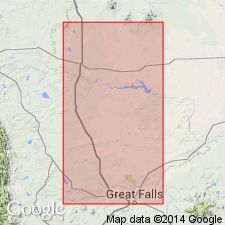
- Usage in publication:
-
- Cone calcareous member*
- Modifications:
-
- Named
- Dominant lithology:
-
- Shale
- AAPG geologic province:
-
- Sweetgrass arch
Summary:
Named as a member of Marias River shale (new) of Colorado group (rank raised) for a USGS vertical-angle bench mark (VABM) "Cone" in NW1/4 SE1/4 sec 13, T22N, R1W, Toole Co, MT on the Sweetgrass arch. Is about 54 ft thick at type. Is a highly calcareous dark gray shale containing numerous minute white specks. Constitutes the "Second white speck" zone of subsurface geologists. At type includes: a 4 ft bentonite bed present 12 ft above base; a persistent bed of large discrete septarian concretions of dark gray limestone present at base; and several thin, ledge-making, clastic fossiliferous limestone beds present at top. Overlies Floweree member (new) of Marias River unconformably. Underlies Ferdig shale member (new) of Marias River unconformably. Correlates with Greenhorn formation or limestone, and with Fairport member of Carlile shale. Is of Turonian, Late Cretaceous age. Correlation chart.
Source: GNU records (USGS DDS-6; Denver GNULEX).
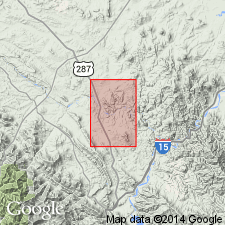
- Usage in publication:
-
- Cone Calcareous Member*
- Modifications:
-
- Overview
- AAPG geologic province:
-
- Montana folded belt
Summary:
Is mapped with Floweree Shale Member of Marias River Shale in eastern Lewis and Clark Co, MT in Montana folded belt province. Overlies Floweree Member of Marias River; underlies Ferdig Shale Member of Marias River. Is chiefly dark-gray and dark-brownish-gray calcareous shale; commonly a few thin beds of olive-gray calcareous siltstone with fish scales near top; one or more thin beds of yellowish-gray and yellowish-orange bentonite; large septarian limestone concretions at base; several thin, clastic, fossiliferous limestone beds locally at top; invertebrate fossils abundant; mainly INOCERAMUS LABIATUS (Schlotheim); about 60 ft thick. Age is Late Cretaceous. [I. LABIATUS is early Turonian in molluscan zonation of Obradovich and Cobban (1975).]
Source: GNU records (USGS DDS-6; Denver GNULEX).
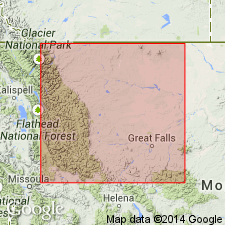
- Usage in publication:
-
- Cone Member*
- Modifications:
-
- Redescribed
- Overview
- Dominant lithology:
-
- Shale
- Limestone
- Bentonite
- AAPG geologic province:
-
- Sweetgrass arch
Summary:
Redescribed--term calcareous removed from name. Designated Cone Member second from base of four members of Marias River Shale of Colorado Group. Of uniform thickness of 15-18 m over much of Sweetgrass arch. Is 16 m thick at type where it overlies Bootlegger Member of Blackleaf Formation and underlies Ferdig Member of Marias River. Crops out at many localities on the South arch and in the Disturbed belt. Consists of dark-gray calcareous shale, dark-gray, shaly to argillaceous limestone, and bentonite. Contains numerous marine fossils. Of Cenomanian, Late Cretaceous age.
Source: GNU records (USGS DDS-6; Denver GNULEX).
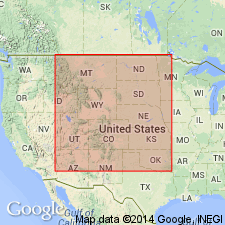
- Usage in publication:
-
- Cone Member*
- Modifications:
-
- Biostratigraphic dating
- AAPG geologic province:
-
- Sweetgrass arch
- Montana folded belt
Summary:
Is [second of four] members in Marias River Shale in Glacier and Teton Cos, MT, Sweetgrass arch, and Lewis and Clark Co, MT, Montana folded belt province. Age (in part) is early Turonian (Late Cretaceous) on basis of ammonites WATINOCERAS REESIDEI identified from USGS Mesozoic localities D558 and D1481, and W. HATTINI n. sp. identified from USGS Mesozoic localities D521 and D3171. Fauna places it within upper zone of tripartite ammonite zonation of the early Turonian. Paratypes of W. HATTINI n. sp. also noted to occur in lower part of Jetmore Chalk Member of Greenhorn Limestone in KS.
Source: GNU records (USGS DDS-6; Denver GNULEX).
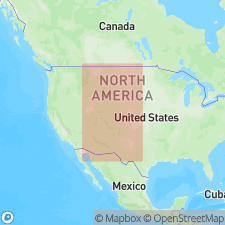
- Usage in publication:
-
- Cone Member*
- Modifications:
-
- Biostratigraphic dating
- AAPG geologic province:
-
- Sweetgrass arch
Summary:
Is member of Marias River Shale in northwest MT. Age (in part) is latest Cenomanian (Late Cretaceous) based on presence of the ammonite NEOCARDIOCERAS JUDDII from lower part at USGS Mesozoic localities 24615, Cascade Co, MT and D556, Teton Co, MT on the Sweetgrass arch. Is thus assignable to N. JUDDII zone.
Source: GNU records (USGS DDS-6; Denver GNULEX).
For more information, please contact Nancy Stamm, Geologic Names Committee Secretary.
Asterisk (*) indicates published by U.S. Geological Survey authors.
"No current usage" (†) implies that a name has been abandoned or has fallen into disuse. Former usage and, if known, replacement name given in parentheses ( ).
Slash (/) indicates name conflicts with nomenclatural guidelines (CSN, 1933; ACSN, 1961, 1970; NACSN, 1983, 2005, 2021). May be explained within brackets ([ ]).

